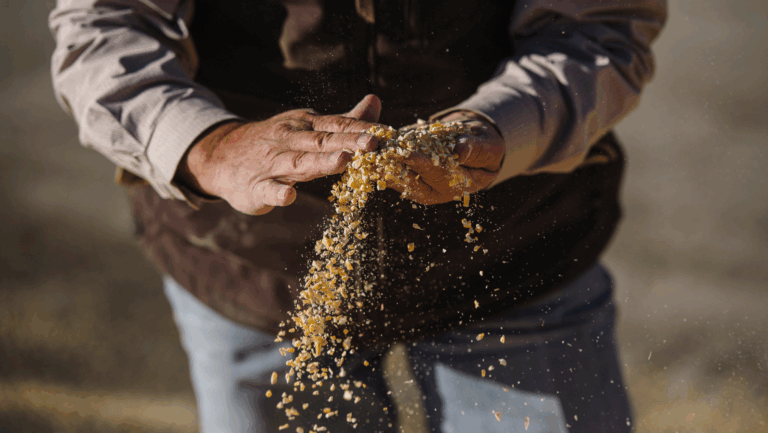Increasing Farm Cash Flow to Ease Financial Stress
The challenges of farming often lead to even greater rewards.
Farming requires perseverance and dedication, but it also requires personal sacrifice. Farmers often must navigate complicated challenges in order to provide food for a growing global population. The unyielding courage and unwavering perseverance of farmers often make the toll that farming can have on mental health go unseen.
Through
out history, farmers and ranchers have been subject to multiple factors outside of their control that impact the success of their operations. These challenges include rising input costs, market fluctuations, severe weather, and labor shortages.
“I don’t really feel like it’s ever been an option to give up. We have to make a choice to be resilient through every situation that is thrown at us. If we decide to hang our hat up, and the next farm decides to hang their hat up, where’s the food going to come from?”
By acknowledging the impacts this can have on the mental health of farmers, we can begin to break down the barriers and focus on overcoming these challenges. While it is impossible to avoid the effects of uncontrollable variables, you can control how you prepare and respond.
Factors Impacting Farm Mental Health
From relationships to physical well-being, poor mental health can impact many facets of a farmer’s life. In 2012, the suicide rate of male farmers, ranchers, and other agricultural managers was double the rate of the general population according to data from the CDC.
Often, an operation’s finances can serve as a main source of stress—placing pressure on individuals to make decisions that have long-term impacts. Leading factors that constrict farm cash flow and therefore have an impact on mental health include:
- Severe weather;
- Labor shortages;
- Rising production expenses; and
- Supply chain shortages.
“You put up your life’s savings in literally betting the farm to make a crop every year with potential for natural disasters and other things that are completely outside of your control that you have to factor into your business model.”
Severe Weather
Unpredictable weather fluctuations challenge farmers around the world. For instance, from 2000 to 2019, major disasters around the world increased by 74 percent compared to 1980 to 1999. In fact, losses in 2021 from severe weather totaled more than $145 billion.
The current drought in the West has been placing significant strain on farmers and ranchers as water becomes more expensive and difficult to source. Water regulations and shortages are leading many farmers to fallow portions of their fields in order to dedicate water to a less water-intensive crop. The California Farm Water Organization projects $3B in negative economic impacts due to drought in 2022.
Labor Shortages
Finding labor for farm work continues to challenge farmers and ranchers across the nation. Navigating the H-2A program is one of the central issues impacting American farmers and ranchers due to its limitations. In addition, sourcing labor and high labor costs are additional roadblocks that can make sourcing labor difficult.
Rising Production Expenses and Supply Chain Shortages
Particularly in the last year, rising input costs are causing financial and mental stress for farmers. The USDA expects 2022 production expenses to climb by 7.3 percent. Due to factors like the increase in fertilizer costs and surging commodity prices, farmers and ranchers are paying more for essential inputs. In addition, supply chain shortages and bottlenecks, particularly at ports, have led to price increases across the board.
As inflation continues to affect farm profit margins in 2022, farmers and ranchers will need to optimize their operational cash flow to minimize the impact.
Prepare for the Future by Optimizing Farm Cash Flow
While the factors mentioned above are mostly out of your control, taking the time to prepare for inevitable challenges in the future can help alleviate future stress. Because farm stress goes hand-in-hand with financial stress, being proactive about managing your finances can set your operation up for success. Working capital is a defense against uncontrollable variables like rising input costs and severe weather events. Building up a strong balance sheet by securing working capital can help prepare your operation for rising input costs and the aftermath of weather events. Restructuring and simplifying existing debt can improve loan terms and lower payments to increase immediate liquidity.
Another loan option to boost working capital is AgAmerica’s interest-only transitional loans. When recovering from financial loss, this interest-only payment structure can help you build up your working capital in the short term to support an operation that thrives in the long term. Transitional loans can be converted to long-term conventional loans when the time is right.
As a farmer, your profession naturally involves stressful decisions—but you don’t have to do it alone. Having a lender in your corner who sticks by your side through the ups and downs makes all the difference. We appreciate all that you do for our nation—and we realize that there is no future without you. That’s why we make it our mission to support you through both the good times and the challenging ones.
Southeast Landowners Improve Farm Cash Flow After Drought
After regaining financial traction after drought, Southeast borrowers returned to AgAmerica to transition their interest-only loan into a long-term conventional loan with a $40K cash out. By improving their loan terms and increasing their cash flow, they were able to support a more financially resilient operation.






